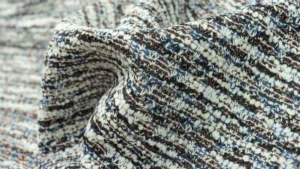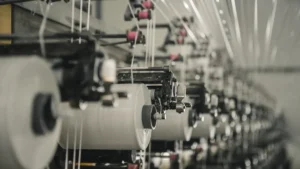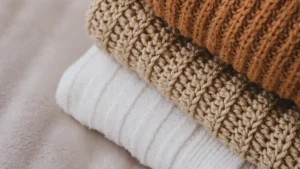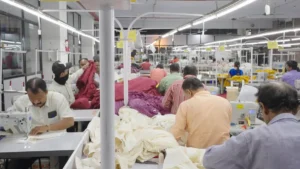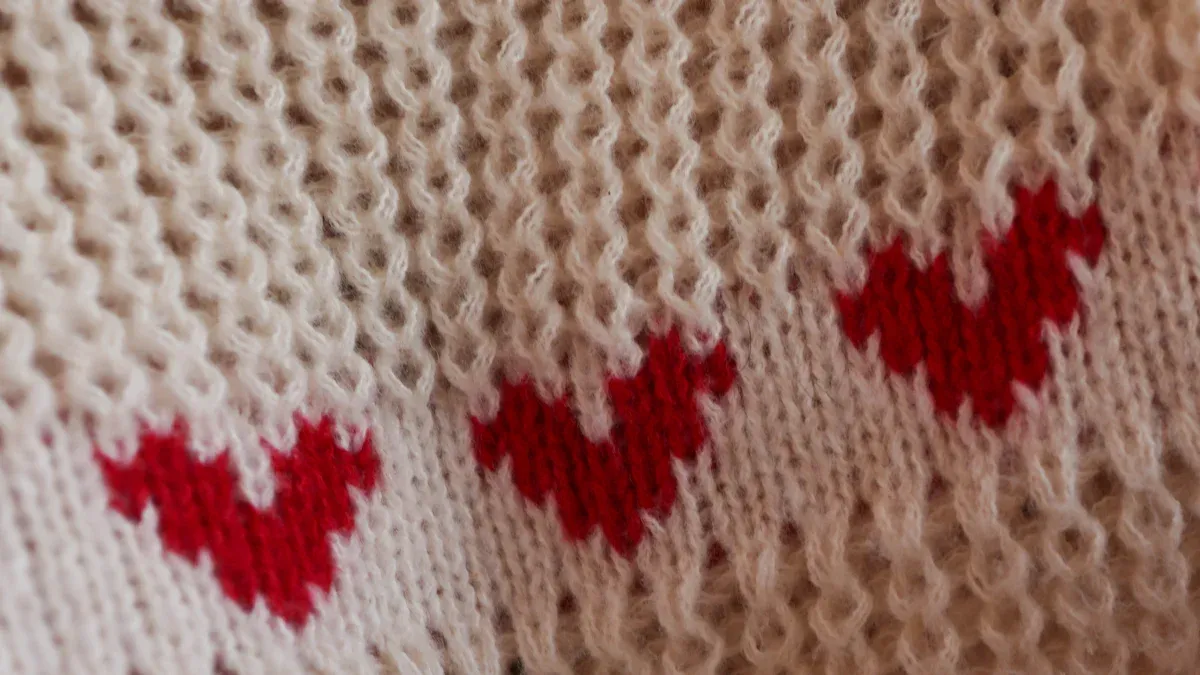
You can create beautiful embroidery on knits by choosing the right stitches for each type of fabric. Factors like stitch density, fabric thickness, and structure play a crucial role. Research shows that using more stitches can make seams in cotton knits up to 37% stronger and more durable. Whether you use hand embroidery or machine techniques, it’s important to consider how much the fabric stretches and returns to its original shape. Select stitches that move with the fabric to prevent distortion. When done correctly, your embroidery on knits will withstand many washes and maintain its quality.
Key Takeaways
Choose embroidery stitches that stretch and move with your knit fabric to keep designs neat and strong.
Use the right stabilizer, like cut-away for stretchy knits, to support your fabric and prevent distortion.
Pick stitches based on your knit type: backstitch for jersey, chain stitch for chunky knits, and bold stitches for textured knits.
Always test your stitches and thread tension on fabric scraps to avoid puckering and thread breaks.
Avoid overstretching fabric in the hoop and keep designs simple to make your embroidery last longer and look better.
Stitch Guide for Knit Fabrics
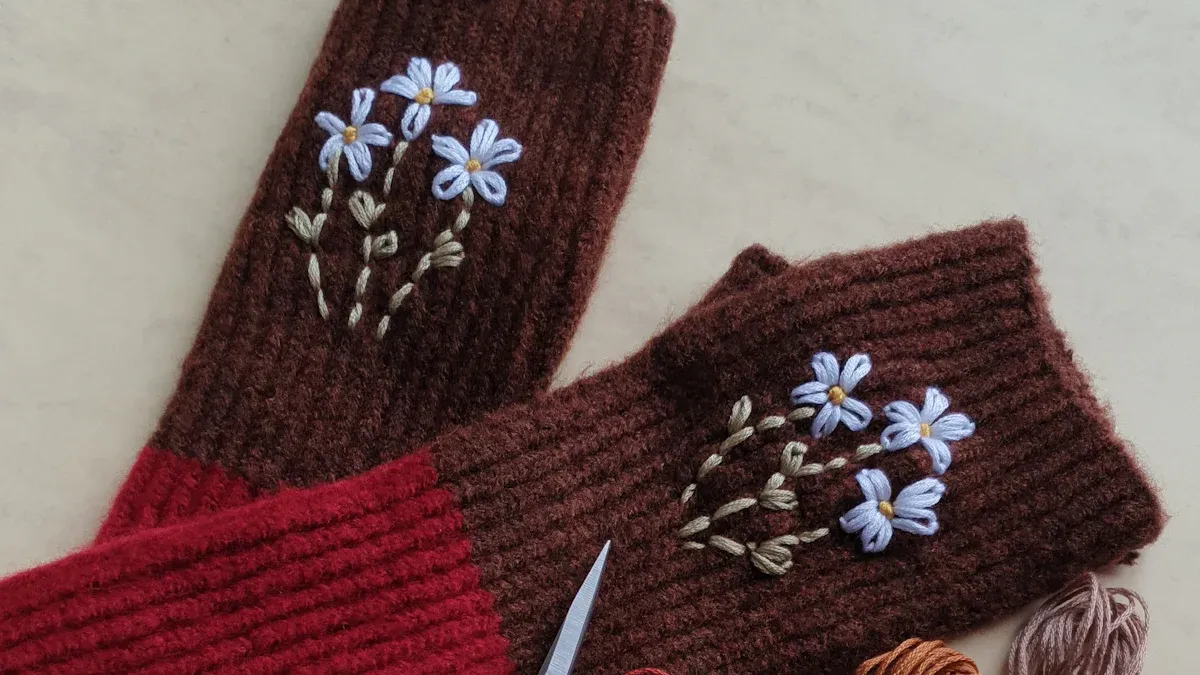
Picking the right stitch for each knit fabric helps you make strong and pretty embroidery. The chart below shows which stitches work best with different knit fabrics:
Recommended Stitches | Notes | |
|---|---|---|
Backstitch, Split Stitch, Stem Stitch | These stitches bend and stretch easily | |
Rib Knit | Satin Stitch, Chain Stitch, Couching | Stitch sideways and use extra support |
Interlock Knit | Running Stitch, Outline Stitch | This fabric is firm and holds details |
Chain Stitch, Blanket Stitch, Darning | Good for fixing and showing stitches | |
Specialty Knits | Bullion Knot, French Knot, Chain Variations | Makes your work bumpy and cool |
Jersey Knit Stitches
Jersey knit is the most used knit fabric. You can use backstitch, split stitch, or stem stitch by hand or machine. These stitches move with the fabric and stop it from wrinkling. Studies say jersey knit with stretchy yarns is very flexible. It is great for designs that need to bend.
Rib Knit Stitches
Rib knit has lines that go up and down and stretches a lot. Satin stitch, chain stitch, and couching are best for this fabric. Stitch across the ribs and use extra layers to keep the shape. For thick rib knits, use pull compensation and edge run underlay to keep things tidy. Stretch rib knit hats before you sew to help your design stay in place.
Interlock Knit Stitches
Interlock knit is smooth and does not move much. Running stitch and outline stitch help you make neat and small designs. The fabric is thick enough for thin lines and tiny shapes. Use a stabilizer and put the fabric in a hoop so it does not move.
Sweater Knit Stitches
Sweater knits are thick and stretch a lot. Flexible stitches like chain stitch, blanket stitch, and darning work well. Darning methods like duplicate stitch and Scotch darning make worn spots stronger and look nice. Use wool yarn and strong needles for the best results.
Specialty Knit Stitches
Specialty knits let you try new looks. Bullion knots, French knots, and chain stitch changes make your work stand out. Special threads like shiny or thick yarns add sparkle and fun. Pick the right needle and change the tension so your stitches stay neat.
Tip: For thin or thick knits, start with a waste knot or loop method. This keeps your thread from coming loose and makes your embroidery last longer.
Knit Fabric Characteristics
Stretch and Recovery
You need to understand how much your knit fabric stretches and returns to shape. Stretch and recovery affect how your embroidery looks and lasts. If your fabric stretches a lot but does not recover well, your stitches may look loose or wavy after washing. You can measure stretch by pulling a 10 cm strip and seeing how far it goes. Recovery shows how close the fabric returns to its original length. The table below shows typical stretch percentages for different types of knit fabric:
Knit Fabric Type | Stretch Percentage |
|---|---|
French Terry | 20%-30% |
20%-30% | |
Jersey | 40%-60% |
Lycra/Spandex | 75%-100% |
0% |
To test at home:
Place two pins at the start and end of 10 cm.
Stretch the fabric and see how far it goes.
Release and check if it returns to the original spot.
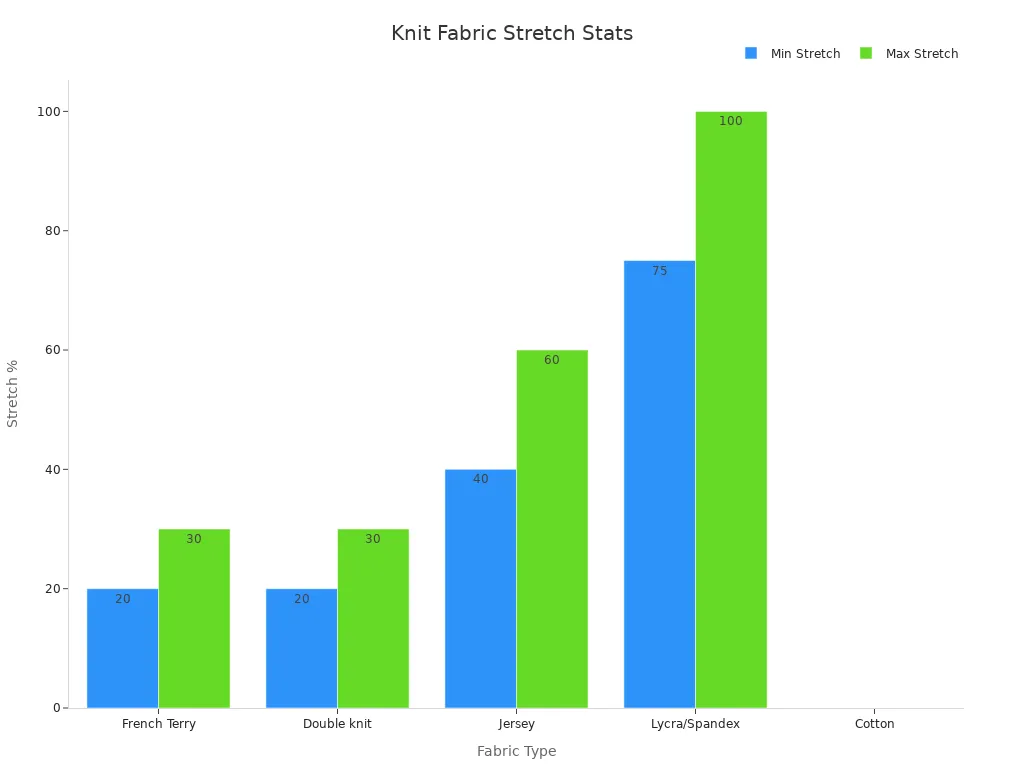
Tip: Choose stitches that move with your knit fabric’s stretch and recovery. This helps your embroidery stay neat and strong.
Thickness and Density
The thickness and density of your knit fabric change how your stitches sit and hold up. Thick or dense fabrics support heavier stitches, while thin fabrics need lighter stitches. The table below shows how different stitches affect thickness and stability:
Parameter | No Embroidery | Lock Stitch | Moss Stitch |
|---|---|---|---|
Thickness Change Rate (%) | 9.63 | 26.55 | 65.03 |
Compression Resilience (%) | Highest | 46.8 | 31.6 |
Compressional Energy | 0.19 | 0.76 | 4.51 |
Moss stitch creates a thicker, bouncier surface but can stretch out more. Lock stitch gives a flatter look and holds shape better. Always match your stitch type to the thickness and density of your knit fabric for best results.
Surface Texture
Surface texture affects how your embroidery stands out. Smooth knit fabric lets you make fine lines and small details. Bumpy or fuzzy surfaces, like sweater knits, work better with bold stitches that show up well. You should always feel your fabric before you start. This helps you pick stitches that look good and stay in place.
Note: The structure of your knit fabric guides your stitch choice. Stable, dense knits let you use more detailed designs. Stretchy, loose knits need flexible stitches to avoid puckering or distortion.
Best Stitches by Knit Type
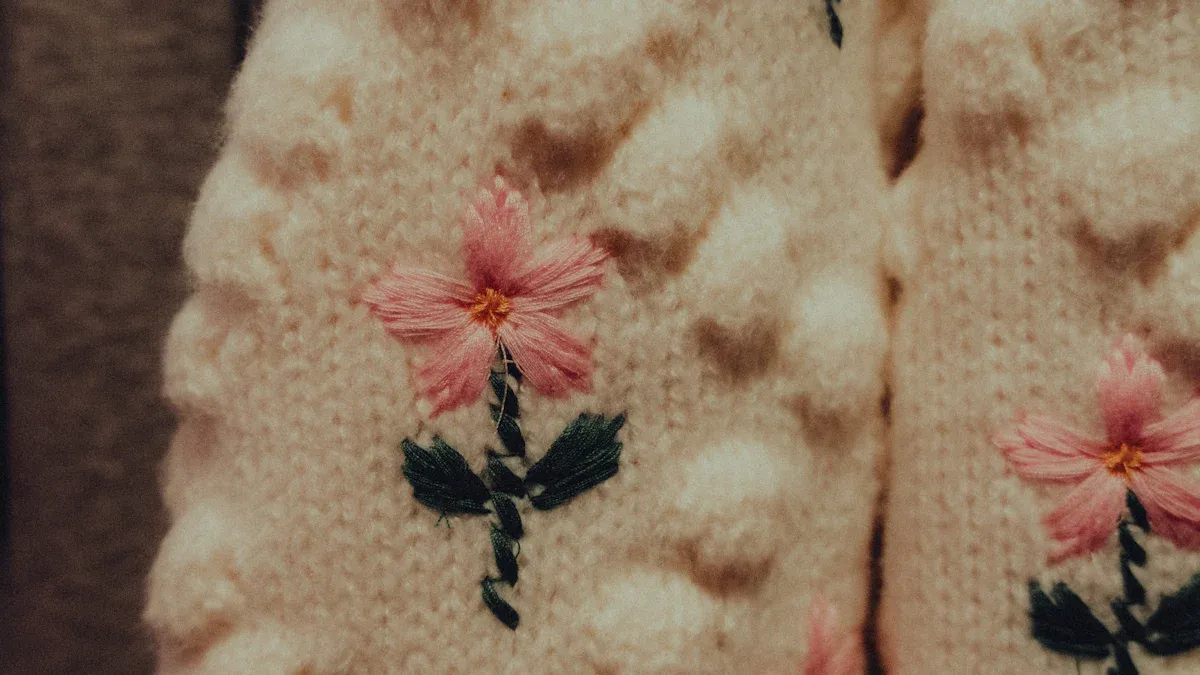
Fine Knits
Fine knits, such as lightweight jersey or tricot, require careful stitch selection. You want stitches that stretch with the fabric and do not cause puckering or holes. For these fabrics, use narrow zigzag, lightning bolt, or stretch stitches. These stitches move with the fabric and keep your embroidery smooth. Avoid heavy stitches that can damage delicate fibers.
Here is a quick reference table for fine knit stitches:
Stitch Type | Description & Suitability for Fine Knits |
|---|---|
Narrow Zigzag | Offers stretch and strength. Adjust width and length for best results. |
Triple Zigzag (Tricot) | Good for hems and necklines. Allows stretch but may be too wide for seams. |
Lightning Bolt (Stretch) | Shaped for knits. Stretches without breaking. Adjust for fabric weight. |
Triple Straight Stitch | Very strong but not for lightweight knits. Can damage fine fabric. |
Serger & Coverstitch | Machines create stretchable seams and hems. Ideal for fine knits. |
When you do hand embroidery on fine knits, use a waste knot or loop method to anchor your thread. Choose fine, soft threads like cotton or silk. Keep your embroidery designs simple and avoid dense patterns. Small, open shapes work best and help the fabric keep its stretch.
Tip: Always test your stitch on a fabric scrap. This helps you see if the stitch pulls or distorts the knit.
Chunky Knits
Chunky knits, such as sweater knits or bulky rib knits, need sturdy stitches that show up well on thick surfaces. You want stitches that sit on top of the fabric and do not sink in. Chain stitch, blanket stitch, and darning work well for hand embroidery on chunky knits. These stitches create bold lines and add texture.
For chunky knits, use thicker threads or yarns. Wool yarn gives a classic look and stands out against the fabric. When you start, use the waste knot or loop method to keep your thread secure. Large needles help you move through the thick fabric without snagging.
Keep your embroidery designs large and bold. Small, detailed patterns can get lost in the texture. Choose open shapes and avoid dense fills. This keeps your embroidery flexible and prevents the fabric from stretching out of shape.
Note: Chunky knits can stretch under the weight of embroidery. Use a stabilizer or hoop to keep your fabric steady while you work.
Textured Knits
Textured knits, such as waffle, cable, or bouclé, present unique challenges. The surface can be uneven, so you need to adjust your technique. Start by hooping the knit fabric with a stabilizer. Make sure the hoop is snug but not too tight to avoid marks.
Follow these best practices for embroidery on textured knits:
Use heavy-weight tear-away stabilizers or spunbond for support. For open knits, try organza as a backing.
Prevent hoop burn by wrapping the hoop or placing a soft cloth between the fabric and hoop.
Select rounded needle points (size 70/10 to 75/11) to match the knit thickness.
Choose soft threads like rayon or cotton for smooth stitching.
Pick embroidery designs with open, bold elements. Satin stitches should be between 1.8 mm and 7-8 mm wide.
Split long stitches over 8 mm or use short filling stitches to avoid snagging.
Increase pull compensation by 20-30% to prevent puckering.
Manually add underlays, such as edge runs or double zig-zags, for extra stability.
Set stitch density at a moderate level (0.35–0.45 mm).
Overlap stitch segments by 2-3 rows to avoid gaps.
Use water-soluble topping on top of the knit to create a smooth surface.
For hand embroidery, always hoop the fabric and stabilizer together. This prevents shifting and keeps your stitches even. Test your thread color by twisting strands and laying them on the fabric. This helps you see how the color stands out against the texture.
Tip: Choose designs with low to medium stitch density and open areas. This keeps your embroidery flexible and comfortable to wear.
Embroidery on Knits: Practical Tips
Stabilizing Knit Fabrics
You should make your fabric stable before you start embroidery on knits. Cut-away stabilizers are best for most stretchy fabrics. They stay on the fabric and give support that lasts. This helps stop the fabric from getting pulled out of shape by about half compared to tear-away stabilizers. If your design is thick or your fabric is not strong, use two layers of stabilizer. This stops the fabric from warping. The table below shows which stabilizer to pick:
Stabilizer Type | Best For | Key Benefit |
|---|---|---|
Cut-away | Knit/stretchy fabrics | Permanent support, prevents distortion |
Tear-away | Woven fabrics | Temporary support, easy removal |
Water soluble | Sheer/delicate fabrics | Dissolves after stitching, less used for knits |
Tip: Pick a stabilizer that matches your fabric’s weight and how thick your design is. This gives you the best results.
Needle and Thread Choices
The right needle and thread help your embroidery look neat and last longer. Use a ballpoint needle, like size 75/11, for most knits. The rounded end slides between the yarns and does not poke holes. This keeps the fabric safe. For thread, use poly core or texturized polyester for basic seams. Wooly nylon is good in the looper if you want more stretch. Do not use a needle that is too small for your thread. This can make the thread break.
Ballpoint needles stop snags.
Corespun or bonded nylon threads keep stitches from coming undone.
Change the tension so your fabric does not pucker.
Using an Embroidery Hoop
An embroidery hoop holds your fabric steady and keeps your stitches even. Some brands, like Brother and Baby Lock, make hoops that let you change the tightness. This helps stop the fabric from getting pulled out of shape. Magnetic hoops, like MaggieFrame, hold knits in place without stretching them. You can also try the “basting in the hoop” method. This means you sew the fabric to the stabilizer before you start. It keeps the fabric from moving. This is good for soft or stretchy knits.
Preventing Distortion
You want your embroidery on knits to look sharp and last a long time. Use cut-away stabilizers for support that stays. Put the fabric in the hoop so it is flat but not stretched. Magnetic hoops spread out the pressure and help stop puckering. Change your machine’s speed and tension for smooth stitches. These steps help you keep your fabric stable and stop problems like puckering or uneven stitches.
Embroidery on Knit: Common Mistakes
Embroidery on knit fabrics can look great and last a long time if you avoid some common mistakes. Knowing what to look out for helps you get better results and keeps your projects looking nice.
Overstretching
Sometimes, you might pull your fabric too much when putting it in the hoop or while stitching. This can make your embroidery look wavy or stretched out after you take off the hoop. Pulling too hard can also make the fabric weak and change its shape. Always put your knit fabric in the hoop so it is flat but not stretched. Let the stabilizer hold the fabric steady.
Tip: Smooth the fabric gently in the hoop, but do not pull it tight. After you finish, the fabric should go back to its normal shape without puckers.
Skipping Stabilizer
A lot of beginners forget to use a stabilizer, but this can make the fabric bunch up and the stitches look messy. Knits need extra help because they stretch and move. Cut-away stabilizers are best for most knits. Tear-away stabilizers are for woven fabrics and do not give enough support for stretchy knits. If you use the wrong stabilizer or none at all, your design can get ruined.
Common stabilizer mistakes include:
Using tear-away backing on knits
Not hooping both the fabric and stabilizer together
Forgetting a water-soluble topper on fabrics with a nap
Note: Always pick a stabilizer that matches your fabric and how thick your design is for the best results.
Dense Designs
Very thick embroidery designs can cause trouble on knits. Too many stitches in one spot make the fabric stiff and can cause puckers or even holes. Hard patterns with sharp corners or lines that cross can break after washing. You should pick open, simple designs for knits and change the stitch amount to fit the fabric’s thickness.
Do not fill big areas with heavy stitches.
Try your design on a scrap piece before you start your project.
Thread Tension
Wrong thread tension can make your stitches look bad and hurt the fabric. If the tension is too tight, the stitches pull the fabric and make puckers. If it is too loose, the stitches can loop or get tangled. Always check both the top and bobbin tension before you start. Use a ballpoint needle for knits and change the tension for your thread.
Problem | Cause | Solution |
|---|---|---|
Tight tension | Loosen top thread tension | |
Loops or tangles | Loose tension or old needle | Tighten tension, change needle |
Thread breaks | Damaged needle, wrong thread | Replace needle, use right thread |
Tip: Test your tension on a scrap of your knit fabric. This helps you find problems early and makes sure your stitches are smooth and even.
You can make pretty embroidery on knit fabrics if you pick the right stitches for each kind. Backstitch or split stitch works well for jersey. Use chain stitch for chunky knits. Pick bold stitches for textured knits. Always use a stabilizer and test your stitches first.
Pick stitches that stretch with your fabric
Use the right stabilizer to help your fabric
Make your designs simple and easy to bend
Tip: Try out new stitches and practice on extra fabric pieces. Each project helps you get better and feel more sure of your skills.
FAQ
What stabilizer works best for stretchy knit fabrics?
You should use a cut-away stabilizer for most stretchy knits. This type gives permanent support and keeps your embroidery from shifting or stretching out of shape. Always match the stabilizer weight to your fabric for the best results.
Can you embroider on very thin or sheer knits?
Yes, you can embroider on thin or sheer knits. Choose lightweight designs and use a fine needle. Place a water-soluble stabilizer on top and a cut-away stabilizer underneath. Test your stitches on a scrap first to avoid puckering.
How do you stop embroidery from puckering on knits?
To prevent puckering, hoop your fabric and stabilizer together without stretching the knit. Use a ballpoint needle and adjust thread tension. Pick open, simple designs. Test your setup on a fabric scrap before starting your main project.
Which hand embroidery stitches work best for beginners on knits?
You can start with backstitch, split stitch, or chain stitch. These stitches move with the fabric and are easy to learn. Use a waste knot or loop method to secure your thread. Practice on extra fabric to build your skills.
Do you need a special needle for machine embroidery on knits?
Yes, you should use a ballpoint or stretch needle for machine embroidery on knits. The rounded tip slides between the yarns and prevents snags or holes. This keeps your fabric smooth and your stitches even.



